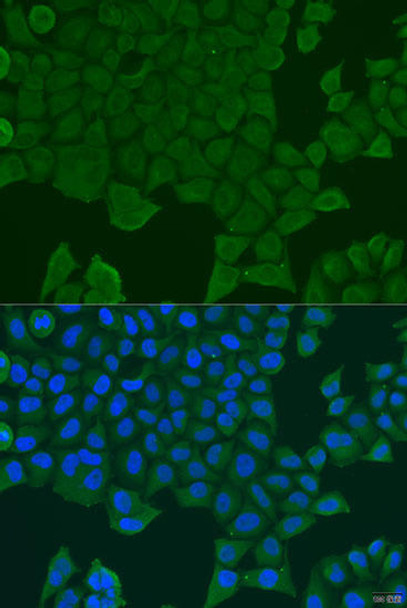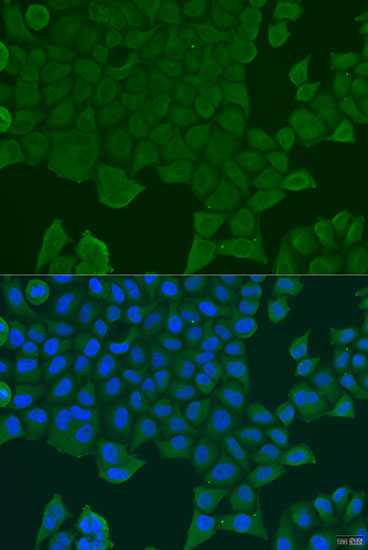Anti-REEP1 Antibody (CAB7832)
- SKU:
- CAB7832
- Product type:
- Antibody
- Reactivity:
- Human
- Reactivity:
- Mouse
- Reactivity:
- Rat
- Host Species:
- Rabbit
- Isotype:
- IgG
- Antibody Type:
- Polyclonal Antibody
- Research Area:
- Cell Biology
Frequently bought together:
Description
| 抗体名: | Anti-REEP1 Antibody |
| 抗体コード: | CAB7832 |
| 抗体サイズ: | 20uL, 50uL, 100uL |
| 申し込み: | WB IF |
| 反応性: | Human, Mouse, Rat |
| 宿主種: | Rabbit |
| 免疫原: | Recombinant fusion protein containing a sequence corresponding to amino acids 101-201 of human REEP1 (NP_075063.1). |
| 申し込み: | WB IF |
| 推奨希釈: | WB 1:500 - 1:2000 IF 1:50 - 1:200 |
| 反応性: | Human, Mouse, Rat |
| ポジティブサンプル: | Mouse brain, Mouse spinal cord, Rat brain |
| 免疫原: | Recombinant fusion protein containing a sequence corresponding to amino acids 101-201 of human REEP1 (NP_075063.1). |
| 精製方法: | Affinity purification |
| ストレージバッファ: | Store at -20'C. Avoid freeze / thaw cycles. Buffer: PBS with 0.02% sodium azide, 50% glycerol, pH7.3. |
| アイソタイプ: | IgG |
| 順序: | KEID DCLV QAKD RSYD ALVH FGKR GLNV AATA AVMA ASKG QGAL SERL RSFS MQDL TTIR GDGA PAPS GPPP PGSG RASG KHGQ PKMS RSAS ESAS SSGT A |
| 遺伝子ID: | 65055 |
| Uniprot: | Q9H902 |
| セルラーロケーション: | Endoplasmic reticulum, Membrane, Mitochondrion membrane, Multi-pass membrane protein |
| 計算された分子量: | 16kDa/18kDa/22kDa |
| 観察された分子量: | 22kDa |
| 同義語: | REEP1, C2orf23, HMN5B, SPG31, Yip2a |
| バックグラウンド: | This gene encodes a mitochondrial protein that functions to enhance the cell surface expression of odorant receptors. Mutations in this gene cause spastic paraplegia autosomal dominant type 31, a neurodegenerative disorder. Alternative splicing results in multiple transcript variants. |
| UniProt Protein Function: | REEP1: Required for endoplasmic reticulum (ER) network formation, shaping and remodeling; it links ER tubules to the cytoskeleton. May also enhance the cell surface expression of odorant receptors. Defects in REEP1 are the cause of spastic paraplegia autosomal dominant type 31 (SPG31). Spastic paraplegia is a neurodegenerative disorder characterized by a slow, gradual, progressive weakness and spasticity of the lower limbs. Rate of progression and the severity of symptoms are quite variable. Initial symptoms may include difficulty with balance, weakness and stiffness in the legs, muscle spasms, and dragging the toes when walking. In some forms of the disorder, bladder symptoms (such as incontinence) may appear, or the weakness and stiffness may spread to other parts of the body. Belongs to the DP1 family. 4 isoforms of the human protein are produced by alternative splicing. |
| UniProt Protein Details: | Protein type:Membrane protein, multi-pass; Membrane protein, integral Chromosomal Location of Human Ortholog: 2p11.2 Cellular Component: endoplasmic reticulum membrane; membrane; endoplasmic reticulum; cytoplasm; mitochondrial membrane; integral to membrane Molecular Function:olfactory receptor binding; protein binding; microtubule binding Biological Process: regulation of intracellular transport; protein insertion into membrane Disease: Neuronopathy, Distal Hereditary Motor, Type Vb; Spastic Paraplegia 31, Autosomal Dominant |
| NCBI Summary: | This gene encodes a mitochondrial protein that functions to enhance the cell surface expression of odorant receptors. Mutations in this gene cause spastic paraplegia autosomal dominant type 31, a neurodegenerative disorder. Alternative splicing results in multiple transcript variants. [provided by RefSeq, Sep 2009] |
| UniProt Code: | Q9H902 |
| NCBI GenInfo Identifier: | 257900516 |
| NCBI Gene ID: | 65055 |
| NCBI Accession: | NP_001158202.1 |
| UniProt Related Accession: | Q9H902 |
| Molecular Weight: | 30kDa |
| NCBI Full Name: | receptor expression-enhancing protein 1 isoform 1 |
| NCBI Synonym Full Names: | receptor accessory protein 1 |
| NCBI Official Symbol: | REEP1 |
| NCBI Official Synonym Symbols: | HMN5B; SPG31; Yip2a; C2orf23 |
| NCBI Protein Information: | receptor expression-enhancing protein 1 |
| UniProt Protein Name: | Receptor expression-enhancing protein 1 |
| Protein Family: | Receptor expression-enhancing protein |
| UniProt Gene Name: | REEP1 |
| UniProt Entry Name: | REEP1_HUMAN |
View AllClose



